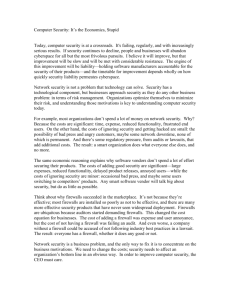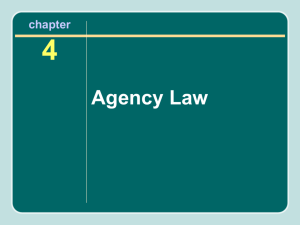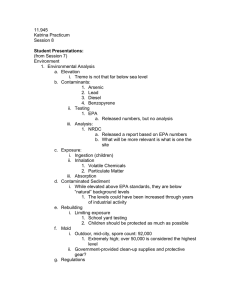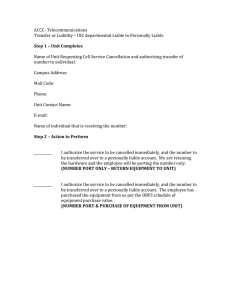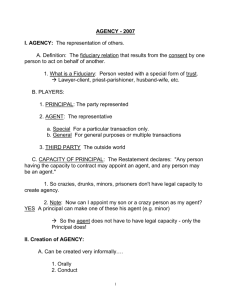Vicarious Liability: Case Notes & Legal Principles
advertisement
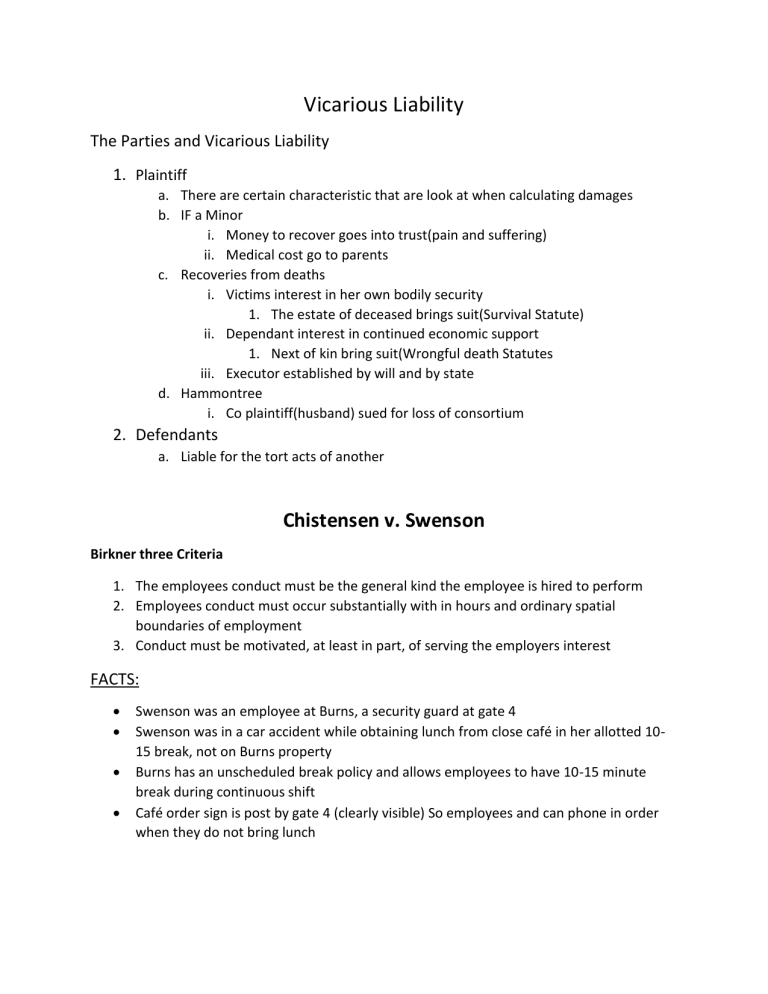
Vicarious Liability The Parties and Vicarious Liability 1. Plaintiff a. There are certain characteristic that are look at when calculating damages b. IF a Minor i. Money to recover goes into trust(pain and suffering) ii. Medical cost go to parents c. Recoveries from deaths i. Victims interest in her own bodily security 1. The estate of deceased brings suit(Survival Statute) ii. Dependant interest in continued economic support 1. Next of kin bring suit(Wrongful death Statutes iii. Executor established by will and by state d. Hammontree i. Co plaintiff(husband) sued for loss of consortium 2. Defendants a. Liable for the tort acts of another Chistensen v. Swenson Birkner three Criteria 1. The employees conduct must be the general kind the employee is hired to perform 2. Employees conduct must occur substantially with in hours and ordinary spatial boundaries of employment 3. Conduct must be motivated, at least in part, of serving the employers interest FACTS: Swenson was an employee at Burns, a security guard at gate 4 Swenson was in a car accident while obtaining lunch from close café in her allotted 1015 break, not on Burns property Burns has an unscheduled break policy and allows employees to have 10-15 minute break during continuous shift Café order sign is post by gate 4 (clearly visible) So employees and can phone in order when they do not bring lunch Facts applied to Birkner 1. Reasonable minds could differ because a) Burn employeed her to be “seen and see” a. Traveling to café could serve this purpose b. HOWEVER, another guard stated it as a personal endeavor b) Menu was posted in plain view of gate 4 tactfully stationed 2. Hours and spatial bounderies of employment a) Accident occurred within hours Sweson was working b) She was trying to get lunch at closest restaurant to gate a. Company had no policies of leaving post in car on break 3. Conduct motivated by the purpose of serving employeers interest a) Burns manager admit the break promote better working conditions b) Burns “speedy and efficient break” to maximie time at gate HOLDING: Summary Judgement is inappropriate because reasonable could differ as to whether Sweson was acting within the scope of her employment when the accident occurred RULE OF LAW An employer may be held vicariously liable for an employee’s actions that occur within the scope of employment. ISSUE: If an employee isn’t on the company property, can the employer be held vicariously liable for accident that occurred during working hours? 1. What would happen if employee was ordered not to do somethings but did it anyways and caused an accident? 2. Restatement 7.07(2) Keywords are engaging in a course of conduct under employeers control. Lunches break were under the control, Burns stated that only 10-15 minutes breaks could be taken for “eating and restroom” 3.Why do courts and restatements frame their inquiries as they do? What is the underling justification for respondeat superior? 4. Schwartz 3 economic justification of Vicarious Liability 1. Incentive for being selective on employees hires and how their manages 2. Allows employers to discline employees when acting negligently and exposing company to liability 3. Alternatives to reducing liability 5. Third party Vicarious Liability Letting a child drive your car, if in accident owner, not child is liable Statutes and common law decide these in the state 6. Negligent conduct by an employee that is intentional like “assault” Acts based on personal motives, in no way connected to business OR Unusual, unprovoked, outrageous are consider to out of scope in Birken test 7. Do consideration about indemnity affect your conclusion about the basic Doctrine? 8. Employer Negligence Bar employee with history of violence punched guy in face o Court concluded the bar owner acted negligently by not properly screening resumes How does this differ for Respondeat Superior? Employers and Independent Contractor Distinction Independent contractors are not vicariously liable like Hirer of an agent may retain broad general supervision over the jib without turning the relationship into employer/employee Roessler v. Novak FACTS: Roessler was misdiagnosed which lead to him having complication after a surgery and had to stay hospitalized for 2 ½ months The doctor that misdiagnosed him worked at Sarasota Hospital on that day Procedural History Roessler alleges that the doctor who misdiagnosied him was an agent of Sarasota so Sarasota Hospital is Vicariously Liable for the negligence of said doctor Hospital states that Doctor is a independent contractor, not agent o therefore Hospital is not Liable Hospital moved for summary judgment and was granted Found in their favor Issue: May a hospital be held vicariously liable for the acts of a physician who is an independent contractor? HOLDING: Sarasota Memorial should be vicariously liable under the apparent agency theory Reasoning: Roessler went to Sarasota ER, the hospital provided him with health care services and providers. Roessler accepted the doctor provided to him by the hospital o representative authority? DIS: Summary Judgement reversed and remand Concurring: Supreme court needs to simplify or legislation needs to be created to simplify rule of vicarious liable of independent contractors other than the apparent authority doctrine Different patients can have different thoughts and it would be hard for courts to pick and choose Rule: A principle may be held liable for the acts of its (non employee) agent that are within the course and scope of the Agency o A principle may be liable to third party acts of its agent which are in agents apparent authority o Apparent authority: is authority which a principal knowingly tolerates or permits, or which the principle by its actions or words hold the agent out as possessing. Apparent agency: exist ONLY IF all three of the following elements are present: 1. Representation by purported principle(lead people to believe that they were an employee) 2. A reliance on that representation by a third party(Plaintiff relied on that”white coat that said Sarasota Hospital”) 3. Change in position by the third party in reliance on the representation a. In order to not rely, you have to refuse service 4. ** principles creates the appearance of an agency itself Chapter 3&4 for Monday Direct Liability - Negligent credentials Un clean conditions Not enough people on staff Unsupervised doctors Ostensible Agency: - There is an essence that there was an employee/employer relationship Three different liability claims Borrowed service : is a defense; used a lot in hospital with nurses Torts Problem 1: Direct Liability: not supervising him, not looking at credential We don’t know if he is a employee or an independent contractor The traditional theory liability: whe you steal that is an intentional tort, so is getting drunk at work. SO to defend sears you claim intentional tort which collapses the traditional theory Carol covers up sign When you have problems state the facts we don’t know and then talk about who if you had those facts Carols needs to prove two committed a tort(5 elements) and that he was an employee - Duty special relationship because employee/employer Breach was in contract when he broke the fridge When she covered up warning, she took part in the tort If he is an independent contract: - Obstensible Agency Apparent Agent He worked for sear If she had know he didn’t work for sears that she would turn him away*** show with historically evidence **She trust sears and if she thinks sear vets employees, had she known she would turned him away*** SUING CAROL: - Because she in control and owns the property Covered up the sign warning about impact

